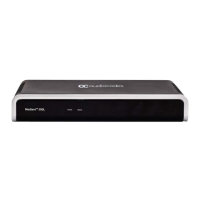Version 7.2 295 Mediant 1000B Gateway & E-SBC
User's Manual 16. Quality of Experience
16 Quality of Experience
This chapter describes how to configure the Quality of Experience feature.
16.1 Reporting Voice Quality of Experience to SEM
The device can be configured to report voice (media) Quality of Experience (QoE) to
AudioCodes' Session Experience Manager (SEM) server, a plug-in for AudioCodes EMS.
The reports include real-time metrics of the quality of the actual call experience, which are
then processed by the SEM.
SEM is a VoIP-quality monitoring and analysis tool. SEM provides comprehensive details
on voice traffic quality, allowing system administrators to quickly identify, fix and prevent
issues that could affect the voice calling experience in enterprise and service provider VoIP
networks. IT managers and administrators can employ SEM in their VoIP networks to
guarantee effective utilization, smooth performance, reliable QoS levels, and SLA
fulfillment.
Note: For information on the SEM server, refer to the SEM User's Manual.
16.1.1 Configuring the SEM Server
The device can report QoE voice metrics to a single SEM server or to two SEM servers
deployed in a Geographic Redundancy, High-Availability (HA) mode. Geographic
Redundancy is when each SEM/EMS server is located in a different network subnet and
has its own IP address. For the device to report QoE to both servers, you need to configure
the IP address of each server. For normal HA mode, when both SEM/EMS servers are
located in the same subnet, a single SEM/EMS server (global, virtual) IP address is used
for all network components (EMS clients and managed devices). Thus, in such a setup,
you need to configure only this IP address.
You can also configure the device to use a TLS connection with the SEM server. Before
you can do this, configure a TLS Context (certificates) in the TLS Contexts table (see
''Configuring TLS Certificate Contexts'' on page 103). If no TLS Context is specified, the
device uses the default TLS Context (ID 0).
You can also configure at what stage of the call the device must send the report to the
SEM server. The report can be sent during the call or only at the end of the call. Reporting
at the end of the call may be beneficial when network congestion occurs, as this reduces
bandwidth usage over time.
Note: If a QoE traffic overflow is experienced between SEM and the device, the
device sends the QoE data only at the end of the call, regardless of your settings.
For a detailed description of the SEM parameters, see ''Quality of Experience Parameters''
on page 970.

